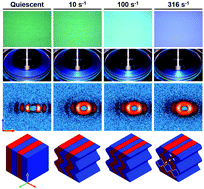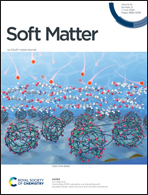Color, structure, and rheology of a diblock bottlebrush copolymer solution†
Abstract
A structure–property–process relation is established for a diblock bottlebrush copolymer solution, through a combination of rheo-neutron scattering, imaging, and rheological measurements. Polylactic acid-b-polystyrene diblock bottlebrush copolymers were dispersed in toluene with a concentration of 175 mg ml−1, where they self-assembled into a lamellar phase. All measurements were carried out at 5 °C. The solution color, as observed in reflection, is shown to be a function of the shear rate. Under equilibrium and near-equilibrium conditions, the solution has a green color. At low shear rates the solution remains green, while at intermediate rates the solution is cyan. At the highest rates applied the solution is indigo. The lamellar spacing is shown to be a decreasing function of shear rate, partially accounting for the color change. The lamellae are oriented ‘face-on’ with the wall under quiescence and low shear rates, while a switch to ‘edge-on’ is observed at the highest shear rates, where the reflected color disappears. The intramolecular distance between bottlebrush polymers does not change with shear rate, although at high shear rates, the bottlebrush polymers are preferentially aligned in the vorticity direction within the lamellae. We therefore form a consistent relation between structure and function, spanning a wide range of length scales and shear rates.



 Please wait while we load your content...
Please wait while we load your content...